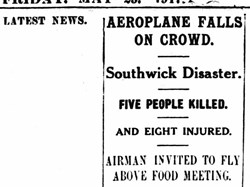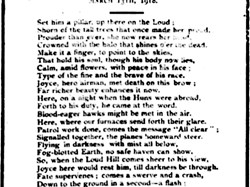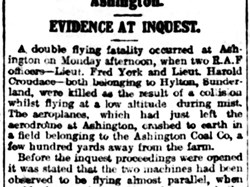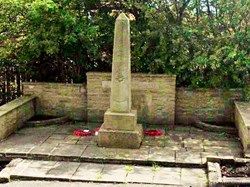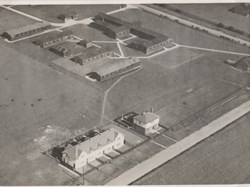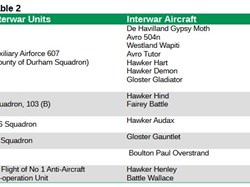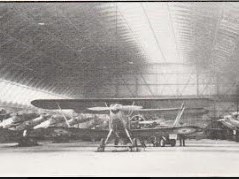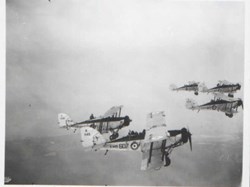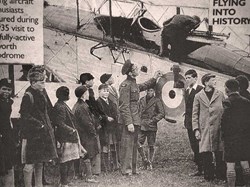RAF Usworth Pt 1 to 1939
The History of RAF Usworth
The site now occupied by the Nissan Motor Manufacturing factory was an active airfield between 1916 and 1984. This is the first part of a two part history of its time as a military base from 1916 to 1939. It draws on the extensive archives of the North East Sea Land and Air Museum (NESLAM) located just over its northern boundary, and recently released military records. Click here for Part 2 the 1939 to 1962 years.
Click here if you prefer a pdf version of the complete story, but note that images cannot be enlarged.
The 1916 – 18 War Years
As German bombing raids increased the Royal Flying Corps took over the task of Home Defence, setting up a number of squadrons with flights spread over the length of the British coastline. The North East was protected by the 36 Home Defence Squadron, formed at Cramlington, Northumberland on 1 February 1916. Land just north of the River Wear, between Washington and Sunderland, was identified for a new, satellite landing field. It was referred to as West Town Moor or Hylton before Usworth became its long term name. There are no maps of the landing field immediately south of Washington Road but it occupied about 110 acres.
Table 1 shows the units (A and B Flights) and their aircraft that operated out of the airfield. Other flights were located at Seaton Carew and Ashington in Northumberland. The main action of the squadron was against Zeppelin raiders in November 1916 and on New Year’s Day 1918.

Early flying was very hazardous. In May 1917 an Usworth aircraft crashed, killing 5 and injured 8 spectators at Southwick Sunderland, though the pilot, Lieutenant Phillip Thompson, survived. Three Usworth airmen died when flying out of Ashington airfield in Northumberland, Lieutenant Alexander Wald in August 1918, and Lieutenants Harold Croudacre and Fred Yorke, when they collided in January 1919.
Another Usworth flyer, Sergeant Pilot Arthur John Joyce, died when he crashed on Pontop Pike between Stanley and Consett in March 1918.
Tragically Sergeant Joyce’s son, Sergeant Dennis Arthur Joyce, was killed in an RAF raid over Germany in 1940. An original memorial built after World War One at Anfield Plain was rebuilt in 1959 as an RAF memorial to those who died in both wars.
(Click on the photographs below to enlarge them)
On 1 September the squadron became part of the Royal Air Force with the merging of the Royal Flying Corps (RFC) and the Royal Naval Air Service (RNAS). However after peace was declared the squadron was disbanded on 13 June 1919.
The Inter-War Years
With the ending of WW1 the land of the airfield was returned to the original owners, and it languished unused for over a decade, apart from a visit by the Alan Cobham’s Flying Circus in July 1929.
The airfield was re-activated on March 17, 1930. The flying field was situated to the south of Washington Road, with ancillary buildings to the north. It was designed to accommodate a squadron of the recently expanded Auxiliary Air Force 607 (County of Durham Squadron). The North Camp provided living quarters for officers, NCOs and airmen. The South Camp included the large Lamella hangar- that survived until 2004- the Squadron Office, pilots huts, armoury, photographic hut and bombing training aids. Alongside the railway were firing butts.
Table 2 shows the units and their aircraft stationed at Usworth. 607 was the home squadron with others posted there for quite short periods. The weekends were busiest, as the part-time Auxiliaries reported for training, that became more intense as war threatened.
(Click on the photographs below to enlarge them)
The Wearside public were entertained by fly-pasts, aerobatics and mock dive bombing during Empire Days from 1934 to 1937, but low cloud and rain stopped the 1938 show. While 2,000 to 3,000 paid to attend, many more watched from nearby fields and hills.
(Click on the photographs below and arrow left and right to enlarge them)
Washington History is very interested in hearing from you if you know more about the the early years of Usworth. Contact us at washingtonhistorysoc@gmail.com
RAF Usworth Pt 2 to 1962 tells the history of the airfield during World War 2 and its remaining years as an RAF base.
